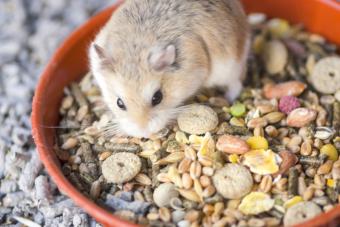hamsters have been a popular choice for pets for many years, and for good reason. They are small, cute, and relatively low-maintenance, making them the perfect companion for both beginner and experienced pet owners.
However, with so many different hamster breeds available, it can be overwhelming to choose the right one for you. Each breed has its own unique personality, temperament, and care requirements, so it’s essential to do your research before bringing home a new furry friend.
In this comprehensive guide, we will explore the world of hamster breeds and help you find the best one to fit your lifestyle.
>> READ MORE:
- Creating the Perfect Hamster Habitat
- Unlocking the Heart of Your Tiny Companion How to Get Your Hamster to Like You
- The Art of Hamster Happiness A Comprehensive Guide to Creating a Thriving Habitat
- The Adorable World of Hamsters An Overview
Understanding the Basics: Hamster Breed Groups

Before delving into specific breeds, it’s essential to understand that hamsters are broadly categorized into three main groups: Syrian, Dwarf, and Hybrid. Each group has its own distinct characteristics and requires different levels of care, so let’s take a closer look at each one.
Syrian Hamsters (Golden Hamsters)

Also known as Golden Hamsters, Syrian hamsters are the largest among all hamster breeds, growing up to 7 inches in length. They are easily recognizable by their golden-brown fur, which gives them a teddy bear-like appearance. Syrians are solitary animals and prefer to live alone, making them an ideal pet for those who want a single companion. They are independent creatures and do not require much attention, making them a suitable choice for busy individuals.
Personality and Temperament
Syrian hamsters have distinct personalities, and each one is unique. Some may be more outgoing and friendly, while others can be shy and introverted. It’s essential to spend time with your Syrian hamster to understand its personality and develop a bond with it. Generally, Syrians are not suitable for households with young children, as they can become agitated or stressed with excessive handling. They are most active during the night, so it’s best to interact with them in the evening.
Care Requirements
Syrian hamsters require a spacious cage with plenty of room for exercise and burrowing. A minimum of 360 square inches of floor space is recommended for their enclosure. You can provide your hamster with commercial hamster food, supplemented with fresh fruits and vegetables. Make sure to clean their cage at least once a week to maintain good hygiene. Syrian hamsters have long fur, which requires regular grooming to avoid tangles and matting. They also need a wheel in their cage for exercise, as they are naturally active animals.
Dwarf Hamsters

Dwarf hamsters are a group of smaller hamster breeds, including Winter White, Campbell’s, Roborovski, and Chinese. These tiny creatures range from 2-4 inches in length and are known for their high energy levels and playful personalities. Unlike Syrian hamsters, Dwarfs can be kept in pairs or small groups, with careful monitoring and introductions.
Personality and Temperament
Each dwarf hamster breed has its own unique personality, but they all share a few common characteristics. They are hyperactive and love to run and play, making them entertaining pets to watch. They are social animals and enjoy the company of other hamsters, but they can also become aggressive if not introduced properly. It’s essential to monitor their interactions and separate them if they show any signs of aggression.
Care Requirements
Dwarf hamsters require a similar diet to Syrian hamsters, with commercial hamster food supplemented with fresh fruits and vegetables. They also need a wheel in their cage for exercise, as well as tunnels and hiding spots to satisfy their natural instinct to burrow. Their cage should have a minimum of 240 square inches of floor space, but the more significant, the better. It’s crucial to keep an eye on their cage cleanliness, as Dwarfs are prone to developing wet tail, a potentially fatal bacterial infection.
Hybrid Hamsters
Hybrid hamsters are the result of cross-breeding between different breeds, resulting in unique combinations of physical characteristics and temperaments. These hamsters are often found in pet stores, but their lineage can be uncertain, making it challenging to predict their behavior and care requirements. The most popular hybrid hamster is the “Teddy Bear” hamster, which is a cross between a Syrian and a Dwarf hamster.
Personality and Temperament
As with any hybrid animal, it can be challenging to predict the personality and temperament of a hybrid hamster. They may exhibit traits from both parent breeds, making them a mix of social and solitary, or active and calm. It’s best to spend time with the specific hybrid hamster you are considering to see if its personality fits your lifestyle.
Care Requirements
Since hybrid hamsters can inherit traits from both parent breeds, it’s essential to research the care requirements of each breed before bringing one home. As a general rule, they will require a larger cage than a Syrian but smaller than a Dwarf. They also need a varied diet, including commercial food, fresh fruits, veggies, and some protein such as mealworms. Regular grooming and exercise are also necessary for hybrid hamsters.
Top 6 Best Hamster Breeds

Now that we understand the basics of hamster breeds let’s take a closer look at the top six best hamster breeds based on personality, size, and care requirements.
1. Syrian Hamster
The Syrian hamster, also known as the Golden Hamster, remains a popular choice among pet owners. They are low-maintenance, have distinct personalities, and are relatively easy to handle. Their size makes them a perfect choice for families with children, as they are sturdier than Dwarf hamsters and can handle more handling.
Pros:
- Solitary nature makes them ideal for those who want a single pet
- Laid back and low-maintenance
- Can be easily handled and trained
- Available in a variety of coat colors and patterns
Cons:
- Require a large cage with ample space to exercise
- Can become aggressive if not given enough space or attention
- Not suitable for households with young children due to their solitary nature
2. Winter White Dwarf Hamster
Winter White Dwarf hamsters, also known as Russian Dwarf hamsters, are tiny, cute, and full of energy. They are social animals and can be kept in pairs or small groups, making them an excellent choice for those looking for multiple pets. Their unique characteristic is that their fur changes color in the winter, giving them a snow-white appearance.
Pros:
- Social animals can be kept in pairs or small groups
- Active and playful, making them entertaining to watch
- Can tolerate handling well if introduced at a young age
- Smaller size means they require less space than Syrian hamsters
Cons:
- Can develop wet tail if not kept in a clean environment
- Can become aggressive if not introduced properly to other hamsters
- Require a diet with more protein than other hamster breeds
- More prone to escaping from their cage due to their small size
3. Campbell’s Dwarf Hamster
Campbell’s Dwarf hamsters closely resemble Winter Whites, but they have a few distinct differences. They have longer tails and rounder faces, and their fur doesn’t change color in the winter. They are social animals and can be kept in pairs or small groups, but they can become territorial if not introduced correctly.
Pros:
- Social animals that can be kept in pairs or small groups
- Active and playful, making them entertaining to watch
- Less prone to wet tail than Winter Whites
- Easy to handle and tame if introduced at a young age
Cons:
- Can become territorial if not introduced correctly to other hamsters
- Require a varied diet with more protein than other hamster breeds
- More prone to escaping from their cage due to their small size
4. Roborovski Dwarf Hamster
Roborovski Dwarf hamsters are the smallest of all hamster breeds, growing to only 2-3 inches in length. They are incredibly active and can run up to five miles each night, so they require plenty of space and exercise. They are social animals and can be kept in pairs or small groups, but they are also known for being skittish and difficult to handle.
Pros:
- Smallest of all hamster breeds, making them perfect for those with limited space
- Social animals that can be kept in pairs or small groups
- Highly active and entertaining to watch
- Less prone to disease and illness compared to other hamster breeds
Cons:
- Difficult to handle and tame due to their skittish nature
- Require a large cage with ample room for exercise and burrowing
- Can become aggressive if not given enough space or attention
5. Chinese Dwarf Hamster
The Chinese Dwarf hamster is often overlooked as a pet due to its nocturnal nature and less cuddly appearance. However, they make excellent pets for experienced owners who are looking for a unique and challenging pet. They have a longer lifespan than other hamster breeds, living up to four years, and they are relatively low-maintenance.
Pros:
- Longer lifespan than other hamster breeds
- Low-maintenance and easy to care for
- Can be kept in pairs, but must be monitored carefully
- Require less space than other dwarf hamster breeds
Cons:
- Nocturnal animals, so they are not suitable for those looking for a daytime pet
- Can become aggressive if not introduced correctly to other hamsters
- Not ideal for handling or cuddling due to their skittish nature
6. Hybrid Hamster (Teddy Bear)
The Teddy Bear, or Fancy Bear, hamster is a popular hybrid breed between Syrian and Dwarf hamsters. They have a unique appearance and can come in various coat colors and patterns, making them a favorite among pet owners. As with all hybrid hamsters, their personality and temperament can vary, but they are generally friendly and social.
Pros:
- Unique appearance with a variety of coat colors and patterns
- Can inherit the best traits from both parent breeds
- Social animals that can be kept in pairs or small groups
- Lower chance of developing genetic health issues compared to purebred hamsters
Cons:
- Require a larger cage than a Syrian but smaller than a Dwarf
- Care requirements may vary depending on the traits inherited from each parent breed
- Can be more expensive than other hamster breeds
Conclusion

Choosing the right hamster breed for you takes careful consideration. It’s essential to understand the characteristics, personalities, and care requirements of each breed before bringing one home. Whether you’re looking for a solitary pet or a group of energetic companions, there is a hamster breed out there for everyone. By considering your lifestyle and preferences, you will find the perfect pocket pal to fit into your life and bring endless joy and love.

